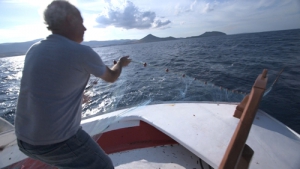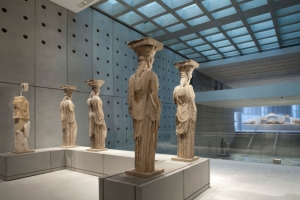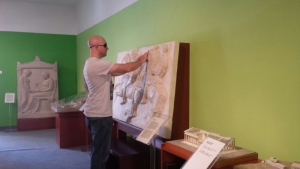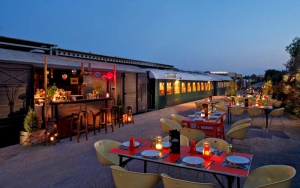LIFE & CULTURE
XpatAthens
Wednesday, 24 June 2015 07:00
Fishing Tourism Given The Green Light
It is one of the most emblematic images of Greece and a favorite for shutterbugs from around the world visiting the islands in the summer: the typical Greek fisherman, seen on a colorful wooden caique casting his nets in the sea, carefully untangling them at the harbor where he comes in every morning to sell his catch or setting off at night to the light of the stars and dozens of small lights strung on the mast of his boat. The world of the professional Greek fisherman has always been a source of wonderment and mystery and now it is open to everyone.
After years of legal and political wrangling, legislation has finally been passed setting the terms and conditions for the development of fishing tourism in Greece – an area of tourism that holds great promise and had been largely untapped. Thanks to the new regulations, professional fishermen can apply for a license that will allow them to take passengers either on pleasure trips or fishing excursions. This not only allows fishermen – already squeezed by competition and over-fishing – to supplement their incomes but also offers a rare opportunity to fans of fishing or people who simply love the sea to enter a completely different world and discover its secrets.
Hundreds of professional fishermen have already applied for the license and are waiting for the coveted piece of paper before the tourism season gets under way in earnest.
“There is a great deal of interest being shown all over the country. The fishermen have been asking for this measure for years and particularly in areas that have a lot of tourism, as this will make it easy for them to have a second source of income. Most fishermen can’t even cover the cost of petrol the way things are right now,” says Giorgos Lourdis, a mechanical engineer by trade but a fisherman at heart, who for years has been trying to promote fishing tourism in Greece.
To read more, please visit: ekathimerini
by
Lina Giannarou
Published in
Local News
Tagged under
Monday, 22 June 2015 16:00
Art Links 2015 - 3 Exhibiting Artists Share Their Creative Inner-Worlds
Art. It’s one of the most joyful and enduring connections between our childhood and adult selves. As children, we paint, draw and shape in order to express our desires, pre-occupations, dreams and fears. Even as adults, we cannot help but echo our truest inner worlds through the art we create.
That’s why Art Links Wishes 2015 (opening on Tuesday June 23 at 8pm at Gallery 7 in Kolonaki until July 3) is such a special collaboration. Art Links Wishes is a group art exhibition that showcases drawing, painting, photography and sculpture, donated by dozens of remarkable Greek and international artists, for the cause of Make-A-Wish Greece (Κάνε-Μια-Ευχή Ελλάδος). Proceeds from the sale of the diverse artworks will help illuminate the lives of seriously-ill children here in Greece through a precious moment of happiness.
‘As with all previous Art Links events, Art Links Wishes 2015 aspires to unite our community through creativity and art,’ says Art Links general manager Sia Corrina Durocher.
Here, three of the event’s exhibiting Greek artists share their own creative inner-worlds with Xpat Athens readers:
MARIA HAJIANDREOU
What is the most enjoyable part of the artistic process for you?
Which theme or themes do you most often return to in your work? (And why?)
What do you wish you had known when you were first starting out?
What is your own personal definition of “success” as an artist?
Which gallery or curator would you most love to come knocking at your door?
Finally, what does living a creative life mean to you?
ANGELIKI MAKRIS
What is the most enjoyable part of the artistic process for you?
Which theme or themes do you most often return to in your work? (And why?)
What do you wish you had known when you were first starting out?
What is your own personal definition of “success” as an artist?
What has been the biggest “highpoint” so far in your art journey?
Which gallery or curator would you most love to come knocking at your door?
Finally, what does living a creative life mean to you?
KONSTANTINOS MASSOS
Which theme or themes do you most often return to in your work? (And why?)
What do you wish you had known when you were first starting out?
Finally, what does living a creative life mean to you?
Participating artists are:
Gallery 7 is at Solonos 20 and Boukourestiou, Kolonaki.)
Story and interviews by: Amanda Dardanis
That’s why Art Links Wishes 2015 (opening on Tuesday June 23 at 8pm at Gallery 7 in Kolonaki until July 3) is such a special collaboration. Art Links Wishes is a group art exhibition that showcases drawing, painting, photography and sculpture, donated by dozens of remarkable Greek and international artists, for the cause of Make-A-Wish Greece (Κάνε-Μια-Ευχή Ελλάδος). Proceeds from the sale of the diverse artworks will help illuminate the lives of seriously-ill children here in Greece through a precious moment of happiness.
‘As with all previous Art Links events, Art Links Wishes 2015 aspires to unite our community through creativity and art,’ says Art Links general manager Sia Corrina Durocher.
Here, three of the event’s exhibiting Greek artists share their own creative inner-worlds with Xpat Athens readers:
MARIA HAJIANDREOU
Hajiandreou was born in Rethymnon, Crete, and studied at the Athens School of Fine Art, where she graduated with first-class Honors. She has participated in many group exhibitions in Greece and abroad, and has given solo exhibitions at Gallery Ora, Gallery Apopsi, Gallery Dimito, Gallery Mylogianni Chania, Gallery 7 and the Cretan Museum of Modern Art, among others.
What is the most enjoyable part of the artistic process for you?
MH: That single moment when you discover that your painting shall produce something of true beauty; something that will keep your energy at full tilt right until its completion.
Which theme or themes do you most often return to in your work? (And why?)
MH:I find myself returning to the human figure, and more specifically, the female figure. Over the years, I’ve worked in still life. My last exhibition consisted entirely of still life drawings. Before that I was fascinated by the gardens and enormous green houses of Scotland. But I always come home to the human figure. My current project has the female figure as its main theme.
What do you wish you had known when you were first starting out?
MH: I wish I’d known how to present myself to the people in the art world better back then.
What is your own personal definition of “success” as an artist?
MH: Success means having evoked emotion in the viewer. The deeper they are moved, the greater you have succeeded.
Which gallery or curator would you most love to come knocking at your door?
MH: If someone from a private gallery in Barcelona or London specialising infigurative painting came knocking, well, that would be very nice.
Finally, what does living a creative life mean to you?
MH:It’s the alpha and omega! If I’m not creating, I’m not living.
ANGELIKI MAKRIS
Piraeus-born Makris studied graphic arts at the Athenian Doxiadis Institute and later continued her studies in the United States and Scotland. She has worked as a cartoonist and illustrator for various newspapers and children's books and has also written books
for children. Her sculptures and paintings have been exhibited in group exhibitions in Greece and abroad. She has held twelve personal exhibitions.
What is the most enjoyable part of the artistic process for you?
AM: I often get angry at what is happening around me and so practicing my art becomes my personal "harbor", my safe haven. In order to create, I first have to empty myself of all the negative emotions and to become a child again, hopeful and carefree. If you cannot change the world, then change yourself. That is my motto.
Which theme or themes do you most often return to in your work? (And why?)
AM: A clearly recurring theme in my work is that of women who exercise, women who flirt, women who get angry. Like an actor, I go through emotional states, through my sculptures, without even realizing it. Moreover, I like cats and seals and other animals as well. There is, however, a common denominator across all these forms: the curve.
What do you wish you had known when you were first starting out?
AM: Self-knowledge. One cannot have too much of it, and the earlier the better. I also wish I were more daring in proposing ideas.
What is your own personal definition of “success” as an artist?
AM: Success, to me, is twofold. Firstly, you have to keep faith in your creative activity and, secondly, you have to be able to convince significant art venues to feature your artworks.
What has been the biggest “highpoint” so far in your art journey?
AM: A milestone in my career-path has been my solo exhibition at the "Zalokosta 7" gallery space, the first time I exhibited my work.
Which gallery or curator would you most love to come knocking at your door?
AM: I am really fond of large-scale exhibitions, public spaces, and, also, art publications. In essence, I am looking to communicate via my work and I am keen to establish a connection with all those who become moved by my art.
Finally, what does living a creative life mean to you?
AM: It takes dedication, isolation, persistence, and self-organization in order to express yourself through art. Art provides me with self-confidence and with the opportunity to become a better person through strengthening elements that give me joy and through avoiding elements that do not.
KONSTANTINOS MASSOS
Massos was born in Athens where he still lives and works as a primary school teacher. In 2014, he graduated from the Athens School of Fine Arts (painting) and his works can be found in private collections across Greece.
What is the most enjoyable part of the artistic process for you?
KM: When after a lot of effort and investigation, the artwork gathers shape and form in terms of the “place” of action, the “heroes” and their feelings.
Which theme or themes do you most often return to in your work? (And why?)
KM: The central theme of my work is the man and the “place” both within him and outside of himself.
What do you wish you had known when you were first starting out?
KM: I have learned to trust and believe in the value of the route that helps me to locate the “new thing or theme” – but which results from a prior knowledge.
What is your own personal definition of “success” as an artist?
KM: I consider successful the artist who manages via his artwork to communicate his feelings and is willing to express everything which takes place around him.
Which gallery or curator would you most love to come knocking at your door?
KM: The Museum of Modern Art (MoMA) and curators like Hans Urlich Obrist and Klaus Biesenbach.
Finally, what does living a creative life mean to you?
KM: Joy, communication, constant searching.
Participating artists are:
Chloe Akrithaki, Daphhne Angelidou, Marie Baha, Maria Chrysohoidou, Evi Feofanidou, Maria Filippakopoulou, George Hadoulis, Vassiliki Haloridi, Maria Hatziandreou, Anastasia Karvela, Nikos Kaskouras, Theophilos Katsipanos, Aggeliki Kokonaki, Mersa Konstopoulou, Giannis Kontaratos, Athina Latinopoulou, Kostas Lavdas, Aggeliki Makri, Konstantinos Mantzaris, Alexia Marouli, Konstantinos Massos, Eleni Mihailou, Tassos Missouras, Kleopatra Moursela, Afrodite Papadouli, Marina Papalabridi, ZachariasPapantoniou,Charikleia Papapostolou, Eleni Pehlivani, Elianna Prokopiou, Miltos Psaros, Chrys Roboras, Peter C. Seibit, Vasilis Skopelitis, Pigi Spyratou, Matina Stavropoulou, Fotini Stefanidi, Nota Tsitoura, Angelika Vaxevanidou
Gallery 7 is at Solonos 20 and Boukourestiou, Kolonaki.)
Story and interviews by: Amanda Dardanis
Published in
Greek Language & Culture
Tagged under
Tuesday, 23 June 2015 07:00
Toasted Chickpeas (Stragalia/Στραγάλια)
Stragalia (στραγάλια) are a delicious, very healthy, totally addictive snack that are so simple to make and a fantastic on-the-go option for work or school too! With coriander and fennel seeds, fresh ground black pepper, salt and garlic, this recipe is the perfect combination of traditional Greek spices. The secret to getting crunchy, nutty good bites every time? A very hot oven!
Because of the high heat necessary for good crunchy chickpeas, it's best to stay away from using dried herbs in this recipe. Dried herbs will often burn and can leave behind an awful, acrid taste. You can safely add dried herbs (Greek oregano or mint) after the chickpeas are cooked and cooled.
The spices are key here so, when you can, toast and grind them yourself. Lightly toast the fennel, coriander and cumin seeds for just a minute or two in a hot pan before grinding coarsely in your mortar and pestle or spice grinder. Grinding the spices all together helps to combine the flavors most evenly.
Then mix the ground spices with olive oil until you get the consistency of a loose paste. Take a sec here, hold your head over the bowl and inhale – the aromas are absolutely intoxicating!
To read more, please visit: The Greek Vegan
Published in
Greek Food & Diet
Tagged under
Monday, 22 June 2015 07:00
The Hellenic Initiative in Australia - Greek Support From Down Under
More than 150 leaders of the Greek-Australian community met in Sydney recently to discuss how to mobilize Australian support for The Hellenic Initiative. Representatives from every state and the two mainland territories attended a dinner event at the Hellenic Club of Sydney’s new Alpha Restaurant, and after a lively discussion there was broad consensus to form an Australian Chapter of THI.
The Hellenic Initiative is a global, non-profit, non-governmental organization, whose vision aims, through the generosity of the Greek Diaspora and the Philhellenic community, to provide substantial encouragement and financial support to help preserve organizations and projects, while also inspiring business growth that will allow Greek people to ensure the long-term prosperity of Greece. The organization encourages the promotion of the necessary structural reforms and private capital investments, which will help to upgrade Greece’s competitiveness.
Apart from Andrew Liveris, founding members of the initiative also include Libra CEO George Logothetis, CEO of The Coca-Cola Company Muhtar Kent, renowned Washington lawyer and investment consultant George Stamas, and George David, chairman of Coca-Cola Hellas.
The event MC was Helen Kapolos of the Seven Network’s Sunday Night program, THI founding member and Dow Chemical CEO Andrew N. Liveris was the keynote speaker. The organizing committee included Nick Mitaros, Nick Pappas, George Giovas, Greg Gav and Penny Maragiannis. Joining the event from the US were THI Executive Committee member Dean Dakolias and John and Mae Calamos.
“This was the first time so many community leaders nationwide have come together to discuss how to organize our community in support of Greece,” said Nick Pappas.
To read more, please visit: Greek Reporter Australia
by
Konstantinos Menzel
Published in
Greece In The News
Tagged under
Monday, 06 March 2017 07:00
The Amazing Whistle Language Of Greece
What if there was a language that only uses whistling for communication and conversation and no words? There is such a language and it exists in Greece.
It is not just about plain whistling sounds or signals, but an actual conversational whistle language!
Sometimes, by meeting people out of the blue and talking to them, you may discover amazing secret hidden gems of culture. When Greek Adventure travelled to South Evia they discovered this Greek secret.
The village this secret is hidden in is called Andia and is located at South Evia, near Cape Cavo D’ Oro. Apparently there is a whistle language used, which has a label by itself. It is called 'Sfyria.' The reason this was born? The locals say they wanted to use a way to communicate across the countryside from long distances. Others claim that it was used to alert people about incoming bandits. Sound travels fast, especially in the wilderness and tops of Greek mountains, so a whole whistle conversational language was born.
The existence of the whistling language of Andia was discovered after an airplane accident happened in the area in 1979. The pilot was missing and search parties went to the area. There, the locals offered their help and they used the 'Sfyria' whistling to communicate across the mountains. No mobiles in 1979!
To read this article in full, please visit: A Greek Adventure
Published in
Greek Language & Culture
Tagged under
Friday, 19 June 2015 07:00
The Acropolis Museum Turns 6!
As part of celebrations for its sixth birthday, the Acropolis Museum will launch a series of exhibitions featuring archaeological treasures from small museums across Greece, with “Samothrace – The Mysteries of the Great Gods” on June 20, 2015.
On the same day, a concert in the museum courtyard will feature the Athens Municipality Philharmonic Orchestra and Choir in works from the interwar period, the cinema and Greek operetta. All exhibition areas and the restaurant will remain open from 8am to midnight and admission will be reduced at 3 euros for all visitors.
On June 21, the museum will organize a scientific conference focusing on recent archaeological research in Samothrace.
Organized in collaboration with ephorates of Rodopi and Evros,under the guidance Samothrace antiquities expert Dimitrios Matsas,the temporary show features 252 ancient artefacts assembled in groups on the basis of their relationship to the island’s sanctuary, where visitors were initiated into the island cult. The exhibit will run through to September 30.
To read more please visit: Greek Travel Pages
Published in
Local News
Tagged under
Thursday, 18 June 2015 12:01
Tactual Museum Athens
What is a Tactual Museum exactly? Read on to find out more.
When Dave Briggs drew the Tactual Museum of Athens as the next museum on his list to visit, he was excited. He'd heard of tactual museums, but had never visited one before. The basic concept is that they are set up as a way for sighted people to experience and understand to a small degree what it must be like to operate in a world without sight. The idea is to be led around a room blindfolded, and then to touch a series of objects in order to understand what they might be.
The Tactual Museum in Athens
The Museum does this with a difference. Rather than using ordinary objects, they instead display copies of artifacts from Ancient Greece. The idea behind this is twofold. Firstly, non-sighted people rarely, if ever, get to touch and feel the relics from an ancient past. These faithful replicas would allow them to do so. Secondly, it would give a chance for sighted people to approach ancient Greece from a new angle, and experience trying to work out what a new object is just by the sense of touch. People are given blindfolds to experience the museum as a non-sighted person would.
There were two rooms downstairs, and several larger rooms upstairs. Some of the smaller objects, such as the golden laurel leaf crown, were especially hard to work out what they were.
Location:
Visitors’ entrance via Lighthouse for The Blind of Greece
Athinas 17, Kallithea, 17673
Hours:
8:00 - 17:00
Museum Website: http://www.tactualmuseum.gr/indexe.htm
Location:
Visitors’ entrance via Lighthouse for The Blind of Greece
Athinas 17, Kallithea, 17673
Hours:
8:00 - 17:00
Museum Website: http://www.tactualmuseum.gr/indexe.htm
To read this article in full please visit: Dave's Travel Pages
Published in
City Discovery
Tagged under
Friday, 19 June 2015 07:00
Tripadvisor: The Ten Best Historic Sites In Greece
These are the top ten sights and landmarks not to be missed in Greece according to the users of Tripadvisor. Based on the votes of travelers themselves, Tripadvisor has come up with a list of the top ten sights and landmarks worth visiting in Greece.
Rather unsurprisingly the top two places go to Greece's most recognizable landmark with the Acropolis hill taking the first spot followed by the Parthenon itself at number 2.
The list also includes Meteora, Delphi and perhaps lesser known monuments such as the Acropolis of Rhodes and the island of Spinalonga which was once home to a leper colony.
Below is the list in full of the top ten places to visit in Greece:
Νο 1 Acropolis
Νο 2 Parthenon - One of the seven wonders of the ancient world
Νο 3 Meteora - The monasteries perched on the tops of imposing cliffs are wonders in their own right and marvels of Byzantine architecture
Νο 4 Delphi - Perhaps the spiritually most important site of the ancient world
Νο 5 Hephaestus Temple in Athens - The best preserved ancient Greek temple in Athens and perhaps the country
To read more, please visit: The TOC
Published in
Travel Greece
Tagged under
Thursday, 18 June 2015 07:00
100 Days Of Solitude - Daphne Kapsali
How far do you need to go to find yourself?
What do you have to give up?
Daphne didn't go very far. After too many years of living as a writer who didn't write, she gave up her life in London to spend 100 days of solitude on the remote Greek island of Sifnos, off season, and find out, once and for all, who she really was. Her challenge: to write every day.
One hundred days and one hundred entries later, her question had been answered in more ways than she could have imagined, and the things she'd given up never mattered in the first place. This book is her story, as personal as it is universal, of the most obvious and most fundamental quest of all: to be happy; to do what you love.
Part memoir, part fiction, part philosophy and part travel writing, 100 days of solitude is a collection of one hundred stories, all of them connected and each one self-contained.
To find out more about this book, please visit Daphne's site at: Daphne Kapsali
Available on Amazon
Published in
Books
Tagged under
Thursday, 18 June 2015 07:00
Apovathra Open Air Bar
Discover “Apovathra”, the outdoor platform of the Railway Carriage Theater to Treno sto Rouf, at Rouf railway station, only ten minutes from the lively Gazi district.
Enjoy refreshing cocktails, delicious Greek snacks, hip DJ sounds, art exhibitions, video screenings and live musical performances. Escape to the coolest spot of the city during summer.
Enjoy the atmosphere among the blooming oleanders and the subdued lighting from the train carriages of the unique Railway Theater.
Address:
“Rouf” Railway Station on Konstantinoupoleos Ave., 11854. (Map: https://goo.gl/maps/0eiDx)
Enjoy refreshing cocktails, delicious Greek snacks, hip DJ sounds, art exhibitions, video screenings and live musical performances. Escape to the coolest spot of the city during summer.
Enjoy the atmosphere among the blooming oleanders and the subdued lighting from the train carriages of the unique Railway Theater.
Address:
“Rouf” Railway Station on Konstantinoupoleos Ave., 11854. (Map: https://goo.gl/maps/0eiDx)
For more, please visit: To Treno Sto Rouf
Published in
Pubs, Bars & Cafes
Tagged under














